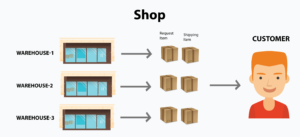

Understanding Magento 2 Multi Source Inventory

Running short of time? Get PDF of the blog in your mail.
On the 1st of December 2018, Magento introduced all the new features of version 2.3
The version came out with really impacting features one of which is Magento 2 Multi Source Inventory (MSI)
What is Magento 2 Multi Source Inventory?
Magento 2 Multi Source Inventory is one of the most anticipated features of Magento 2.3.0.
This feature has eliminated the need for an extra extension needed for inventory reflection of different warehouses.
E.g
If there are 5 warehouses WH1, WH2, WH3, WH4 and WH5.
WH1 has 200 products
WH2 has 350 products
WH3 has 150 products
WH4 has 100 products
WH5 has 300 products
Then the Magento 2 MSI will count the products as per the warehouses and won’t total the products up as 1100 products by counting all the warehouses as one.
The geographical location of the warehouses will be visible and the inventory will be recorded and tracked likewise.
Magento 2 Multi Source Inventory eliminates the need to get an extension just for the purpose of simultaneous monitoring of different sources.
For multi-source sellers who have their warehouses in different cities, this feature will help to manage stocks of multiple warehouses at the same time but individually. It will reflect the products according to the warehouses and not as total from one warehouse.
You can download the feature at https github.com Magento engcom msi
Problems faced Before Magento 2 MSI
Before the introduction of Magento 2 MSI, Magento had SWS (Single Warehouse System) or as we call it Catalog Inventory was there.
SWS counts all the warehouses as one and hence the products in different warehouses are also counted in total and not reflected separately.
E.g.
If a seller has 3 warehouses and 1st warehouse has 50 products, 2nd has 100 products and the 3rd one has 80 products, the SWS system will count them as total 230 products instead of reflecting the warehouses individually along with their products.
This system is suitable for a seller who has one or two warehouses at the same place and doesn’t have a large scale business.
But for a large scale business where the seller has warehouses in different cities, the SWS creates a limitation. Since products in different warehouses are also not individually listed, this created several issues
- If any product went missing there was no way to tell which warehouse was missing the product.
- No record about which product was being dispatched from which warehouse could be maintained.
- Monitoring and handling the warehouses individually was difficult and the procedure took a long time.
- Admin of the website had to look for extensions externally as the Magento frame didn’t include it earlier.
Why is Magento 2 Multi Source Inventory Needed?
The Magento 2 Multi Source Inventory is helpful for the Admin as well as the sellers. Many channels like Amazon, Flipkart etc. have their own warehouses in different cities where the products are stocked. Having a multi-source inventory makes it easy to monitor all the warehouses simultaneously as well. as individually. Product Reflection is not confusing as the products numbers are individually listed as per the warehouse
For the sellers also it makes expansion easy. It helps them to manage multi-channel sales.
How Does it help?
- Listing the same products from different sellers stocked in different warehouses becomes easy as the admin can keep the record of the product by the warehouse location and name of the seller as well.
- Tracking the products from different warehouses at the same time becomes easy.
- Since Magento 2 MSI doesn’t consider multiple warehouses as one warehouse, the cost of shipping is cut down.
- If anyone is planning an expansion, keeping that in mind Magento 2 MSI proves to be helpful. The admin or the vendor will just need to enter the data regarding their new warehouses and then they will be able to keep the record of those warehouses as well.
- If a seller wants to sell his products on multiple channels like Amazon, Shopify, eBay etc, MSI will help him manage the orders for Multiple Channels.
- The Magento 2 MSI will help the sellers with Point of Sales as well. Many sellers sell online and through their brick and mortar stores also. This feature will help separate inventory records for the physical store and online store separately. It is known as split inventory management.
- It helps even if the business is the dropshipping or multi-source selling type. (Dropshipping business means- the sellers don’t keep any stock of the products, rather place the orders to the manufacturers and have them shipped directly to the customers.) managing multiple sources from different geographical locations. With the Magento 2 MSI feature, the sellers can add and manage as many sources as they want at the same time.
Source: dropshipbundles.com
Having all the records and management regarding every single warehouse that an admin or a seller owns in any geographical area at a single place, is now much easier now all thanks to Magento 2 MSI.


